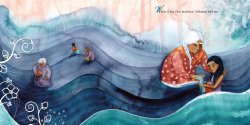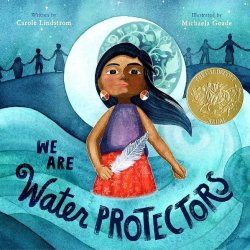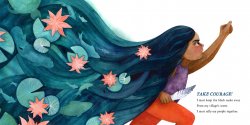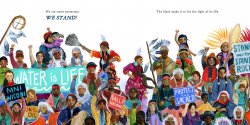
Artwork from We Are Water Protectors by Michaela Goade © 2020 by Macmillan


Review of We Are Water Protectors by Carole Lindstrom (author) and Michaela Goade (artist)
New York: Macmillan, 2020
Reviewed By Peter Shea
Construction on the Dakota Access pipeline was completed in 2017; since then, 500,000 barrels per day have been flowing through the pipeline. We Are Water Protectors makes a powerful statement of the view of those Native and other protesters who demonstrated against the pipeline in 2016: water is sacred, and this construction puts water at unacceptable risk.
Often, children’s picture books promote some relatively uncontroversial good: friendship, wonder, persistence, tolerance – and so the reader or teacher can join the cheering section for the collective wisdom of the adult world, and the school librarian can shelve the book without fearing a visit from the local league of decency. The convention of unproblematic writing for young children also makes it hard for philosophy to get a foothold with such books; once we have all said that we too admire hard work or beautiful butterflies, or that we rejoice when spring comes again, what’s left to talk about? We move on to the next brightly colored celebration of what we all care about.
Michaela Goade draws on Native traditions to picture the proposed pipeline as a giant snake, an evil monster that must be fought, to protect water, which is imaged as the sum of all good and nourishing forces in human life. There’s no nuance to this story. The book begins by holding up a common and universal value, as picture books do, but it quickly becomes an argument in support of a specific policy: this pipeline should not be built.

Artwork from We Are Water Protectors by Michaela Goade © 2020 by Macmillan
As an editor, encountering this book, I want to run away. This is the sort of book that gets banned, the sort of book that makes parents restless, the sort of book that has an agenda. It’s best to stay with safer books: there are plenty of good celebrations of the glories of water. Further, this book aims at young children, and there’s reason to think that the idea of choosing the least bad of several bad alternatives is one to be reserved for adults, for “mature audiences.” How can we expect young children to judge fairly on an issue for which one side – the anti-pipeline side – has been made into legend and world-class pictures? Isn’t it best to keep children in the realm of happy generalities, for a while at least?
Against that, one might say, echoing Greta Thunberg, that some children’s lives will be unfixably affected by whatever happens with the pipeline, or with its successors. Once oil is flowing through $3.78 billion dollars’ worth of pipe, it is very hard to stop. The crucial decisions on this project, the points at which protest could matter, were made in the years before 2017. As concerned adults, we don’t want our children to come to political consciousness only to discover that the decisions that set the dismal tone for their futures were made back while they were still being fed a steady diet of pretty pictures and unproblematic values. We don’t know, in this stage of political history, how to balance the developmental needs of children against the urgency of giving children a voice in their futures as soon as they are willing to assume that responsibility. It isn’t obvious that our children or students will thank us for the luxury of a happy and oblivious childhood. (Remember, Greta Thunberg’s journey to environmental activism began at age eight, and issued in effective protest seven years later. It is very hard to say what the age of majority, or age of reason, is in this strange time.)

Artwork from We Are Water Protectors by Michaela Goade © 2020 by Macmillan
When I was growing up, my teachers, my parents, and the public library were my resources for finding out about the adult world. I would not have had the intellectual energy to move from an emotional plea, like We Are Water Protectors, to a publicly defensible view. I might be impressed by a sermon or a presentation or a story, but my dedication to that feeling would be purely sentimental – childish. But now, anyone, just by asking Google, ‘What are the arguments for oil pipelines?’ can come up with all kinds of questions to ask Lindstrom and Goade: what are the dangers of alternative means of transporting oil, like trains and trucks? What safety precautions are in place around pipelines, and how well have they worked, in similar environments? How soon can the world economy make the transition away from fossil fuels, so that hazardous oil transport is no longer necessary? — Are young children capable of that level of discussion, of weighing options when all the choices have risks, and none promises to give us a really splendid future? I think the answer has to be: we don’t know. The tools for entering the public discussion have never been widely available before. So, it isn’t crazy to think that story time with an eight-year-old, reading We Are Water Protectors, might start a research journey and also an activism journey of depth and intellectual integrity. We just don’t know how this next generation could respond to environmental dangers.
There’s another reason for taking We Are Water Protectors seriously as a provocation to thinking and inquiry. It is one of many superbly-produced expressions of points of view. Debate is not a popular project in the U.S. right now; presidential debates and legislative debates are too often just shouting matches. The contest for hearts and minds happens through emotional appeals, with stories (frequently horror stories) standing in for any kind of careful analysis. Fact-checking just breaks the spell, spoils the story. If parents and librarians and teachers don’t take emotional rhetoric seriously, helping children to appreciate the power of the points being made and also to stand back from those points, to force themselves to ask hard questions about what they want to believe, children will be vulnerable to – be suckers for – the best show in town, their whole lives. That’s an intolerable educational outcome.
So, with fear and trembling, I say: We Are Water Protectors is a beautiful and partisan book, and the teacher or parent who wants to help children to think better could not find a better place to start, giving the child of whatever age the opportunity to feel the force of this plea, and then to recognize the need to understand the political context within which this issue arises, and the honest differences of opinion about policy that arise in an already disrupted world. It will not be easy for adults with strong convictions to help children come to their own views on political matters – to realize the kind of respect that is at the core of Matthew Lipman’s teaching – but, given the urgency of the current problems, that’s the only responsible way forward.


Artwork from We Are Water Protectors by Michaela Goade © 2020 by Macmillan